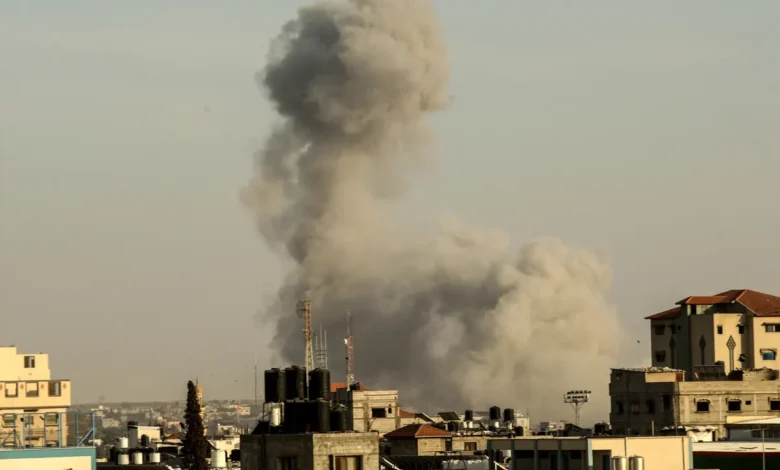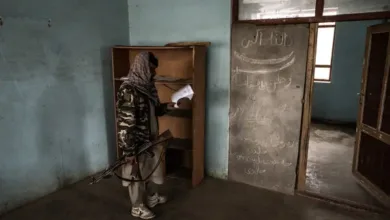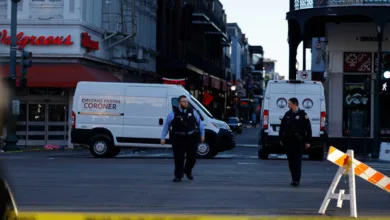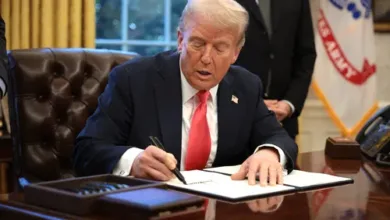Israeli airstrikes on Rafah begin, despite rising ceasefire pressure.

Rafah’s future was in jeopardy on Monday when Hamas declared it had agreed to a cease-fire in exchange for hostages. However, Israel replied doubtfully, announcing it would continue its campaign against the southernmost city of Gaza by conducting bombings at night.
The events of the day left the more than a million Palestinians seeking shelter in Rafah bewildered. Thousands of people fled the city as Israel ordered early on Monday to evacuate a portion of it.
After Hamas said it had accepted a truce, there were public celebrations in the evening, but when Israel responded tepidly and started bombing, there was dismay and confusion.
Table of Contents
The Israeli military announced late on Monday that it was hitting Hamas targets in Rafah with targeted strikes. The only crossing point between Egypt as well as Gaza for people and humanitarian goods, the Rafah border, is on the Palestinian side. There have been claims of Israeli tanks spotted on the eastern edges of Rafah, and the Axios news website quoted anonymous sources claiming Israeli forces intended to seize control of this territory.
Although the accusations were not independently verified, the Associated Press cited Egyptian and Palestinian security officials claiming that Israeli tanks had moved as near as 200 metres from the border. An important lifeline for humanitarian supplies, the Rafah border is especially delicate for Egypt, as it is keen to prevent a large-scale Palestinian exodus into the Sinai peninsula.
Although expressing worry over the attacks on Rafah on Monday, a US official stated they did not think the actions constituted a significant military operation. According to them, US attention was directed towards initiating a similar operation in heavily populated districts of Rafah.
Benjamin Netanyahu, the prime minister of Israel, stated that although Hamas consented to certain measures that were far from satisfying his government’s requests, he would send a delegation to Cairo via Egyptian and Qatari intermediaries to continue discussions. Additionally, the Qatari government declared that William Burns, the head of the CIA, would be joining a delegation that would be travelling to Cairo.
In order to “exert military leverage on Hamas with the objective to facilitate the liberation of the captives along with other goals of the war,” the war cabinet declared that it would continue the operation in Rafah.

According to an Israeli official, it was not clear precisely which plan Hamas was embracing because some of the provisions seemed to be significantly different from what the Israeli government had agreed upon last week and what the mediators had presented Israel. Speaking under anonymity, the official stated, “[We] don’t recognize some.”
Hundreds of Israelis gathered at Tel Aviv’s main military headquarters despite the late hour, demanding a solution immediately. Jerusalem and other Israeli cities reported smaller rallies.
“Hamas’s declaration must open the door for the 132 captives that Hamas has been holding prisoner for the previous seven months to be released. As to a statement released by the captives and Missing Families Forum, “It is now the appropriate moment for all concerned parties to fulfil their obligations and utilise this chance to negotiate the release of all hostages.”
“We maintain our belief that a hostage resolution serves both the Israeli and Palestinian people’s best interests,” stated US State Department spokesman Matthew Miller. We’ll keep trying to achieve a ceasefire since it would bring about an instantaneous one and let more humanitarian aid to be transported.
The durability of a ceasefire was the primary point of contention between the two sides throughout the Cairo negotiations. After the truce has expired, Israel wants to retain the ability to reopen hostilities, especially against the remaining members of Hamas’s military branch in Rafah.
Due to Hamas’s insistence that Israel make the ceasefire permanent from the beginning of the accord rather than negotiating its length after the truce had begun, talks in Cairo seemed to come to a standstill over the weekend.
According to a report in Haaretz, the Hamas version modifies other aspects of the Egyptian agreement proposal, such the need that it release 33 captives in the first phase, and does not immediately demand a permanent truce. Furthermore, it supposedly eliminates Israel’s veto power over the choice of which Palestinian prisoners are freed in return.
According to cited statements from Hamas leaders, the agreement they had agreed to called for a three-phase, forty-two-day truce, rehabilitation of Gaza, the repatriation of displaced Palestinians to their homes, and a prisoner swap. It was unclear from that description if there were significant changes from the proposal that Egyptian mediators had presented last week.
Witnesses reported scared families fleeing Rafah on foot, on donkeys, pushing trolleys, or cramming their belongings into overcrowded trucks hours after studying Israeli military leaflets telling residents as well as displaced people in the eastern neighborhoods to evacuate, even though a ceasefire was far from certain.
Head of UN assistance organisation Unrwa in the region Philippe Lazzarini warned that an Israeli military attack would add another layer of unimaginable misery to the situation facing the people of Gaza. “Reversing the spread of the existing man-made hunger will become even more challenging.”
The US president, Joe Biden, “reiterated his clear position” on Rafah at a Monday afternoon meeting with Netanyahu, according to the White House.
Over a million Palestinians have taken sanctuary in Rafah; US officials have stated repeatedly that Israel must provide a sufficient humanitarian plan for these people, and that the US will alter its regional policy if Israel proceeds with an attack without one.
There was no indication on Monday that such a strategy was feasible given the existing situation, thus the US’s resistance to a Rafah strike was unlikely to wane.
Biden will have the last say on whether changing US policy would result in limits on arms imports. Regarding a story on the news website Axios stating that a shipment of ammunition produced in the United States was scheduled to depart last week, US authorities declined to comment.
Saudi Arabia reacted angrily to the evacuation order, calling Israel’s attack in Gaza a “genocide.” Prior to the conflict, Riyadh was attempting to reach an agreement to restore relations with Israel, and it has not given up on this objective.
As part of their methodical and violent drive to overrun the Gaza Strip and compel its people to flee to safety, the Israeli occupation troops are threatening the city of Rafah, according to a statement from the Saudi foreign ministry.

Over 100,000 people living in an eastern part of Rafah are thought to have received instructions from the Israel Defence Forces (IDF) to go to a “extended humanitarian zone” on the coast, which includes the severely damaged city of Khan Younis. The instructions were disseminated through “announcements, text messages, phone calls, and media broadcasts in Arabic.”
“The purpose of this plan is to evacuate people safely,” an Israeli military spokeswoman stated. “This is not a large-scale evacuation of Rafah; it is limited in scope.”
Given the complete devastation of Gaza following seven months of Israeli shelling, the Biden administration concurs with the UN and relief organisations that there is no safe haven for the residents of Rafah to go to.
Although the Israelis claim that just a small portion of Rafah—roughly 100,000 people—is under evacuation orders, US officials believe that any military action in that area would have a domino effect, frightening a large number of people throughout Rafah and forcing them to go.
Over a million Palestinians who were forced to flee other parts of Gaza due to the conflict have found refuge in Rafah, which also serves as a vital hub for humanitarian efforts throughout the region.
The city is surrounded by densely populated tent encampments, which have already overrun al-Mawasi, the seaside area around three miles northeast, which Israel has ordered residents to flee. Relief workers describe Khan Younis as “completely uninhabitable.”
Both displaced individuals and humanitarian representatives report severe overcrowding, poor food, few fresh water supplies, and nearly complete lack of sanitation in al-Mawasi. In the past several months, Israeli troops have at least twice bombed sites in al-Mawasi.
Aid workers have long warned that a significant Israeli attack in the south would severely hamper efforts to prevent hunger in Gaza. According to the Norwegian Refugee Council, an attack on Rafah would cause “the collapse of the aid response” on Monday.
Although far-right parties have threatened to withhold vital support for Netanyahu’s coalition if a truce deal is reached immediately, Netanyahu has been faced with pressure from inside his own party to make compromises in order to secure the release of the captives in Gaza.
Itamar Ben-Gvir, Israel’s far-right minister of national security, posted on X with the following statement: “The only response to Hamas’ drills and games is an order to take Rafah immediately! Applying more military force and keeping up the total destruction of Hamas until it is destroyed.
People also Reading
Crumbling the Israel-Gaza Clash
Who are the witnesses in the Trump hush money trial?
Demanding a quick truce in Gaza, the United Nations General Assembly votes
Why US stop shorts Ceasefire in Gaza, but UN approves Aid.
Martin Luther King Jr.: Ten Startling Facts
Updates on Ukraine: Russia begins a massive air Campaign.




